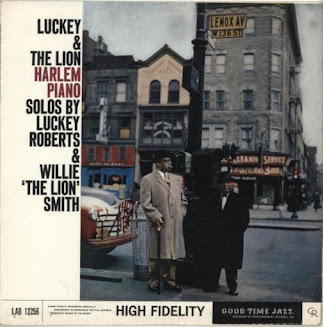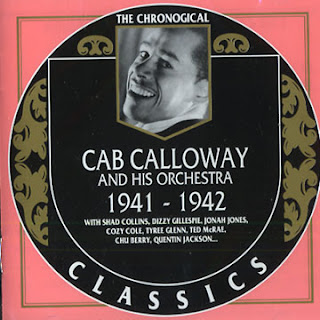Luckey & The Lion - Harlem Piano
Harlem Piano is a treasure of early jazz piano and features two under recorded pianists: Luckey Roberts on side one and Willie "The Lion" Smith on side two. Along with James P. Johnson and Fats Waller, Smith is considered one of the big three in stride piano, but compared to the other two, he is vastly underrepresented in recordings. Luckey Roberts was not so lucky having only nine recorded performances prior to this date. This album was recorded on March 18, 1958, so both men were well past their prime (Roberts was 70 and Smith was 64) but their performances are still strong and provides a fascinating aural experience of the evolution of early jazz piano.
By 1907 Scott Joplin had moved to New York, following his publisher John Stark who had made the move two years prior, thus heightening ragtime's presence in the Big Apple. The cutting sessions at Tom Turpin's Rosebud Bar were alive in the rent parties of Harlem and by 1910, Roberts was a powerhouse among Harlem pianists. In 1913, he became the first Harlem rag player to publish a rag, "Junk Man Rag" published in May and then the follow-up in June, "Pork and Beans". Like his contemporary Eubie Blake and future stride pianists James P. Johnson and Fats Waller, Roberts kept composing and wrote music for shows. He made a few recordings in the 1920s, but only as an accompanist and his first solo piano recordings were not made until he was fifty-nine years old in 1946! The tracks on Harlem Piano comprise the remainder of his entire recorded output. As a result. it's difficult to assess his early playing with any accuracy. But his reputation is strong and this album features a few of his finger busters from his heyday.
"Nothin'" was his signature piece and dates back to 1908. It was never published or copyrighted and it served primarily as weapon at cutting contests. This version from 1958 certainly shows off his technique which was considerable considering his age. There are a few mistakes, but the extravagance and the virtuosity is there. However, it does sound modernized (or at least like stride!) with some classical-type technique and some intense hemiola patterns creating polyrhythm. He relies primarily on his left hand playing an oom-pah pattern (bass note and chord), while his right hand is dashing around. On this tune and others, he relies on ragtime forms, and this one is more complex: AABBA CC DD EE with interludes between the last three sections. It's interesting to hear how the melodic theme at B finishes off where the A section ended.
 "Spanish Fandango" is another older composition and makes use of the rhumba rhythm. In fact, it is the melodic bass line that guides the first section with virtuosic arpeggio decorations in the right hand's upper register. It's very rhapsodic-like and reminds me more of James P. Johnson's later techniques. Roberts also imitates the guitar's tremolo effect on the piano but playing one note with multiple fingers on one hand or with two hands.
"Spanish Fandango" is another older composition and makes use of the rhumba rhythm. In fact, it is the melodic bass line that guides the first section with virtuosic arpeggio decorations in the right hand's upper register. It's very rhapsodic-like and reminds me more of James P. Johnson's later techniques. Roberts also imitates the guitar's tremolo effect on the piano but playing one note with multiple fingers on one hand or with two hands.
Smith's work on Harlem Piano is in this vein and it is remarkably different in approach from Roberts. Besides musical form, it's Smith's palette of expression that seems so much wider and more expressive than Roberts. Smith has a more relaxed approach to time that allows his music. to grow from rubato to full-on stride, and back. There's also his use of dynamics going from very loud to very soft in a matter of seconds. Smith's music is also much more intimate. I kept thinking as I was listening to the music how gentle the music sounded by someone whose nickname was "the Lion"! "Rippling Water" features all of these aspects and is impressionistic in that the music is made to sound like the title. "Morning Air" is also word painting and moves very freely from idea to idea. His music is definitely not meant to be dance music and is more artistic in his ambitions.
Roberts had his own club in Harlem from 1942 to 1954 and producer Nat Hentoff points out that Red Garland was a frequent visitor. It's nice to hear that as this music, especially Roberts', must have felt very out of date and old-fashioned at the time. Perhaps, this is why Roberts played the way he did. Everybody knows ragtime today, but ragtime was a dusty book in the back of the shop that no one wanted to touch in the 1950's. Kudos to Hentoff for recording Roberts and Smith. He recognized the importance of their music during a period when people were trying to piece together the history of jazz.
Luckey Roberts (1887?-1968) represents an important link between the ragtime of Scott Joplin et al. and James P. Johnson. Born and raised in Philadelphia, he was already active as an entertainer on the vaudeville circuit by the time he was five. He became interested in piano and learned ragtime as the music was booming. By beginning of the new century, he was in New York and playing piano at bars and accompanying singers. Taking lessons whenever he could, by 1910 he had a strong reputation as a powerhouse in the Harlem piano scene.
 |
| L-R: Horace Silver, Luckey Roberts, Sahib Shihab, Eddie Locke, and Jimmy Rushing (half-hidden) outtake from "A Great Day In Harlem" photo session, August 12, 1958 |
 |
| A Great Day in Harlem, August 12, 1958; circled: Luckey Roberts. Willie "The Lion" Smith was present but sitting curbside for this photo |
 "Spanish Fandango" is another older composition and makes use of the rhumba rhythm. In fact, it is the melodic bass line that guides the first section with virtuosic arpeggio decorations in the right hand's upper register. It's very rhapsodic-like and reminds me more of James P. Johnson's later techniques. Roberts also imitates the guitar's tremolo effect on the piano but playing one note with multiple fingers on one hand or with two hands.
"Spanish Fandango" is another older composition and makes use of the rhumba rhythm. In fact, it is the melodic bass line that guides the first section with virtuosic arpeggio decorations in the right hand's upper register. It's very rhapsodic-like and reminds me more of James P. Johnson's later techniques. Roberts also imitates the guitar's tremolo effect on the piano but playing one note with multiple fingers on one hand or with two hands. "Railroad Blues" is basically a blues in the form AABBCCA with interludes. Each section contains the same melodic material from the last four-bars. The C section omits the first four bars of the blues form. This tune reminded me a bit of boogie-woogie without the famous left-hand pattern, but the shuffle feel is the same and enables Roberts to create train sounds. "Complainin'" is again based on the blues, but slower. This tune alsot begins with an active bass line as the melody. The form is ABACCA and features a dizzying amount of chords, texture changes, and melodies than compared to say Scott Joplin.
Most of Roberts' compositions are based on piano textures or bass lines. The focus is less melodic and more technical, but "Inner Space" features perhaps his loveliest melodies. It's a waltz and there are some interesting rhythmic ideas: first, playing 2/4 against the 3/4 meter at the end of the first A section. In the B section, the bass line's eighth notes feel like triplets and we've been metrically modulated to 6/8. The C section features some more funny rhythms feeling like its in 6/4 at times. The rhythmic theme is also evident in the number of hi-register piano flourishes that remind me of short drum rolls. The ending also features some beautiful, harp-like chords which are impressionistic by nature.
In spite of all of these modern devices, Roberts' touch and approach to the piano is still based in ragtime. The shuffle blues pieces bounce a little, but the swing feel is not really evident on "Inner Space" or "Nothin'". I wonder too how much, if any, improvisation plays a role in his music. His music sounds like thought-out compositions with techniques embedded to impress. Still, there's a quasi-classical grandness to his music that especially comes out in the C or D themes. He's lost none of the charming qualities of ragtime and at heart that's what this music is, in spite of the stride influences.
WIllie "The Lion" Smith (1893-1973) was raised in Newark and was active in the Harlem piano scene in the 1910s where he encountered Roberts, Eubie Blake, and James P. Johnson. He earned his nickname for his heroism in World War I when his commander called him "a lion with a gun". He returned to New York and became another feared rival at cutting sessions. But while he was a legend in Harlem, his talents as a player and pianist were not recognized until much later in life. He appeared on record in the 1920s, including Mamie Smith's "Crazy Blues" in 1920 but, like Roberts, he was an accompanist only. Clarence Williams published Smith's "Fingerbuster" in 1934, but it was his eight sides for Commodore in 1939 that solidified his reputation as a pianist. By this time, he had been incorporating classical techniques creating vibrant stride work in pieces like "Echo of Spring" and "Passionette".
 |
| Luckey Roberts and Willie "The Lion" Smith outtake from "A Great Day In Harlem" photo session, August 12, 1958 |
"Between the Devil and the Deep Blue Sea" is the sole standard on this record and perhaps the best example of Smith's style. The tune is used as a vehicle for his improvisations (or arrangement) on the theme that is decorated with different piano textures. Although it's a standard tune, the performance is rhapsodic and he has turned it into a piano sonata. It's as if he were using the piano techniques of the Romantic composers (Rachmaninoff, Chopin, Ravel, etc.) but on the simple chord changes of a pop tune! I make it sound like a parody, but it is anything but that as he has sophisticated taste and style. It's brilliant.
I also find it interesting that both men chose to record songs with a "Spanish tinge". I guess mambo was popular in the 1950s, but still I think it has more to do with the repertoire of ragtime and stride which allowed for rhumba rhythms. Smith's "Tango La Caprice" is minor themed and also based on a ragtime-like form: ABACD. He very daintily throws in the modern jazz minor six chord, but that was the only instance bebop I heard (aside from some chromatic harmonies on "Morning Air"), otherwise it is filled with brilliant melodic variations on the theme.
"Relaxin'" is in the AABA song form with contrasting textures for each section. This voicings remind me of big band riffs and I wonder if he is improvising: it is simple enough that he could be. It's a nice chordal section with some pleasant surprises including accents and reharmonizing the tonic as a dominant nine chord. "Concentratin'" is a lovely tune with a nice descending melodic figure in the bass line.
 |
| Luckey Roberts and Willie "The Lion" Smith outtake from "A Great Day In Harlem" photo session, August 12, 1958 |





Comments
Post a Comment